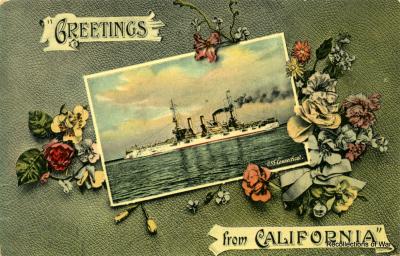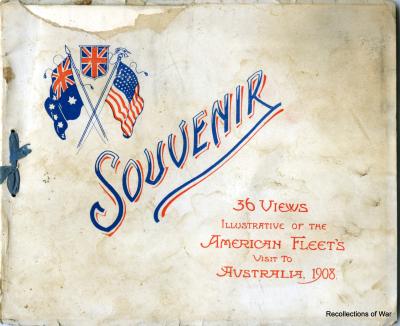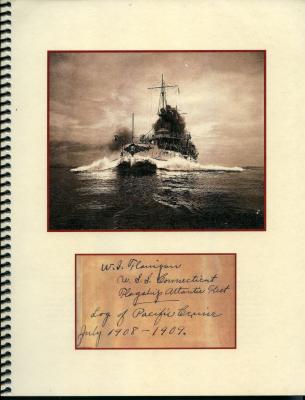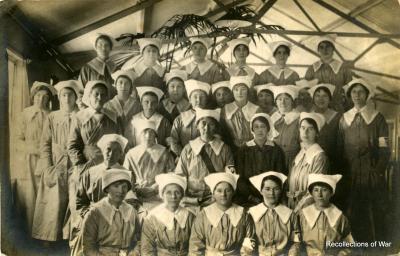WWI Trench art carving made by William Wiper, Royal Engineers
1918Trench art timber carving made by Sapper William Wiper of the Royal Engineers in 1918. It comprises two parts - a thick rectangular base with central curves ending in square corners, and a smaller rectangular carving of a floral design (possibly a rose) attached from the base by four metal screws. A flower, bud, three leaves and a small section of stem are carved in relief on a stippled background.
On the reverse, written in black pen is the name of the maker, the place it was made, and the year. In the top right hand corner is an attached piece of paper stuck to the timber. It is missing a few small pieces around the edges, but the majority of the writing can be deciphered. The timber is identified as teak cut from an Ambulance Railway Coach which was standing at an Étaples hospital. Tools used to make the piece are named.
There is a small metal loop threaded through a metal eyelet at the top of the reverse for hanging.
This carving was made by Sapper William Wiper who served with the Railways Section of the Royal Engineers, service number 55047. He enlisted on 4 December 1914 and was discharged on 8 February 1919.
William Wiper was born on 18 June 1882 in Kendal, Westmorland. In 1911, aged 28, he was working as a Telegraph Linesman with the Signal Department of the Railways in Lancashire. He continued this link with the railways during his war service. He was awarded a pension due to disability after the war and by 1939 was a postmaster. He died in October 1968, aged 86.
The depot at Audruicq (where this item was made) was established in February 1915 when the site (adjacent to the Nord Railway) was chosen for a railway stores depot. By December, a locomotive repair shop for the Railway Operating Department (ROD) of the Royal Engineers had been established and it became the main workshop for the ROD within the British Expeditionary Force. As well as repairing locomotives, it also repaired carriages and wagons. The site also developed into a huge logistics depot, not only for ammunition storage but also for all kinds of stores.
Étaples became the principal depot and transit camp for the British Expeditionary Force in France and also the point to which the wounded were transported. Among the atrocities of the war, the hospitals there were bombed and machine-gunned from the air several times during May 1918. These became known as the hospital raids, and a number of nurses, medical staff and patients were killed and injured. This piece of timber came from one of the Ambulance Railways Coaches used to transport wounded patients and which was standing outside one of the many hospitals that were bombed.
William didn't have many tools at his disposal to make this item, using a penknife and a nail to create the crude carving and make the stippled background.
Details
Details
On reverse of carving in black ink:
"W.Wiper R.E.
Audruicq France
1918"
On reverse of carving on attached piece of paper:
"...was cut at
Audruicq France during British
occupation of that camp.
Cut of teak taken from Ambulance
Railway Coach that was a
portion of one of the trains stand
-ing at Etamples [sic] hospital when
the Germans bombed the whole
of the camp from the air
killing large numbers of nurses &
wounded 1918. Tools used
pocket pen knife...
nail 4" long and the...
W. Wiper R.E."
Other items from Recollections of War
- Souvenir ashtray Vimy War Memorial - dedicated to Frederick Thomas, C.E.F.
- Bisque figurine of a Boer War soldier
- Bisque figurine of a Boer War soldier - 'A Gentleman in Kharki'
- Great White Fleet postcard - U.S.S. Connecticut, California
- Souvenir booklet - '36 Views Illustrative of the American Fleet's visit to Australia, 1908'
- Boomerang purchased by Winfield Ira Flanigan in Sydney during visit of Great White Fleet, 1908
- Winfield Ira Flanigan - Log of Pacific Cruise on U.S.S. Connecticut - Great White Fleet 1908
- The Methodist Church of Australasia booklets issued to A.I. F. Soldiers in WWI
- WWI patriotic good luck charm - black cat
- WWI Australian Y.M.C.A. Service medal awarded to female employees at Aldwych Theatre, London
- WWII 'Make Do and Mend' pantyhose repair kit in form of doll
- WWI photographic postcard of a group of Y.M.C.A workers
Scan this QR code to open this page on your phone ->




